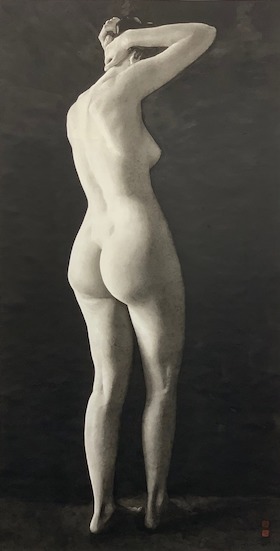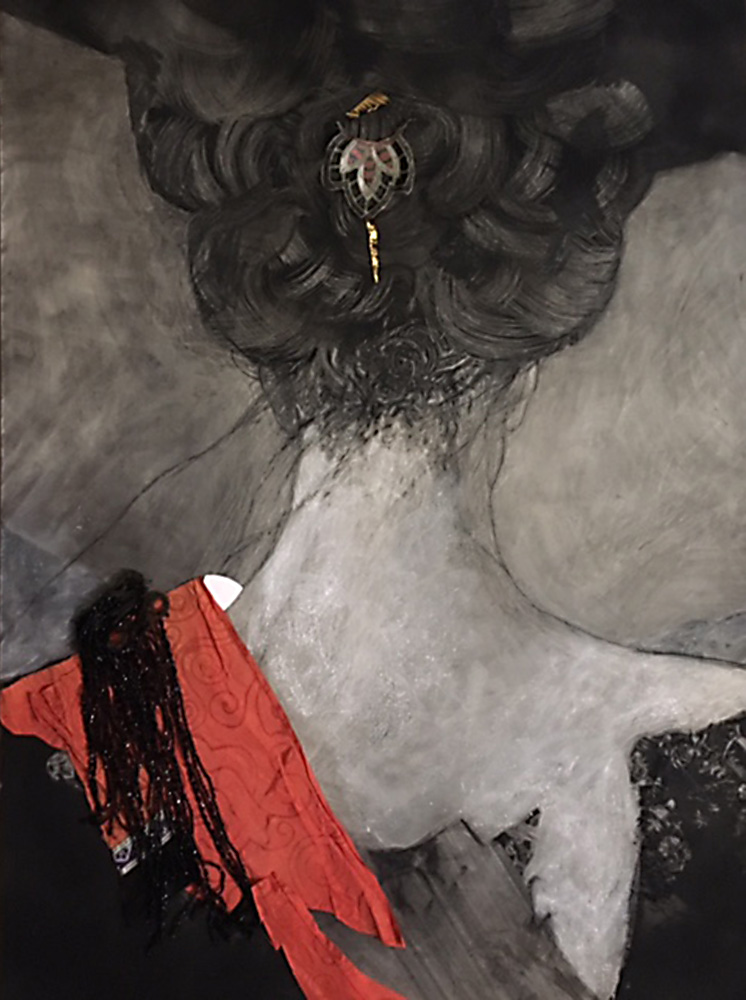QU LEILEI, YE HONGXING & CHRISTIAN DE LAUBADÈRE
Et le peintre croqua la femme
23 August – 27 October 2019
Vernissage: Friday, 23 August 2019 7-9 pm
Art talk with artist QU Lei Lei and Dr Christina Braun
Midissage: Thursday, 26 September 2019 7-9pm
with artist Christian De Laubadère
Baroque Music with „le Salon“ l La Compagnie sensible
Gu Kai-Zhi painted, in the 4th century, an “ode to Luo Shen”, inspired by the poem of his contemporary Tao Yuan-Ming, “The Peach Blossom Spring”. In this first painting of a Chinese woman, Luo Shen, goddess of the Luo River, with fine features and a slender body, shows strength and impassibility in joy as well as in pain. associated with the Yin of the Taoist cosmology, as soft and fragile as water, but unsurpassed in Luo Shen is the ideal of the Chinese woman: carrying away the hard and the strong, she is thereby also associated to the Yang side.
Ye Hong-Xing, Christian de Laubadère and Qu Lei Lei celebrate this female ideal through the prism of their respective sensibilities and experiences.
Ye Hong-Xing, originally from Beijing but already internationally renowned, explores different themes, patterns and materials. Her self-portraits, embedded in the circle of the “everything” or the sky, in the traditional Yin representation of women, are hidden behind the Yang attributes of luxury and money: porcelain motifs, landscapes or personalities appearing on banknotes. She appears to preserve a delicate balance. In doing so, she becomes the spokesperson of a generation of Chinese artists apprehensive to lose the values of their traditional culture, replaced by those of a society obsessed with consumption and appearance.
Christian de Laubadère lived in Shanghai for many years and, among other things, painted napes of Chinese women. When contemplating them, one has the impression of stroking their skin, adjusting their hairstyles and adding accessories: jewels, ribbons, and fabrics which the artist collects. His perfect mastery of the stroke and of the “sfumato”, his artist’s eyes and his immeasurable fantasy captivate anyone who discovers one of these elegant necks. With finesse and mystery, he gives each woman he draws an exceptional value. “Her movements are full of Chinese grace. And, near her, we breathe around her beauty. Something sweet like the smell of tea”, wrote French writer Théophile Gauthier in the nineteenth century, when literature and the Fine Arts used to convey mystery and exoticism. De Laubadère’s napes bewitch those who look at them because they cannot be forgotten.
Qu Lei-Lei, a student during the Cultural Revolution was, in particular, a companion of Ai Weiwei in the “Stars” movement, before moving to London in the 1980’s. Qu Lei-Lei excels in using Chinese ink, he creates effects of shading, volume, contrast and perspective totally foreign to traditional Chinese painting, and was the first Chinese artist to paint nudes of unsurpassable beauty. Qu Lei- Lei also deals with many other subjects and projects, up to the most conceptual ones, and keeps surprising his collectors. His nude paintings, whose aesthetics have their roots in ancient Greece, were unimaginable before him in Chinese painting, and build a bridge not only technical but also aesthetic between Antiquity and the contemporary world. They project unbelievable sweetness and elegance, without any decoration, or one reduced to a cloth, to better celebrate the splendor of the feminine figure.
Going beyond archetypes and the fantasied representation of feminity, these three artists strive to restore woman’s universal and elusive beauty.
Gu Kai-zhi peint, au 4ème siècle, une «ode à Luo Shen», d’après le poème de son contemporain Tao Yuan-ming, «la source aux fleurs de pêcher». Dans cette première peinture d’une femme chinoise, Luo Shen, déesse du fleuve Luo, aux traits fins et au corps gracile, fait preuve de force et d’impassibilité dans la joie comme dans la peine. Luo Shen est l’idéal de la femme chinoise: associée au Yin de la cosmologie taoïste, comme l’eau souple et fragile, mais insurpassable pour emporter le dur et le fort, donc aussi associée au Yang.
Ye Hong-Xing, Christian de Laubadère et Qu Lei Lei célèbrent cet idéal de la femme, dans le prisme de leurs sensibilités et de leurs expériences propres.
Ye Hong-xing, originaire de Pékin mais déjà de renommée internationale, explore différents thèmes, motifs et matériaux. Ses auto-portraits, dans le cercle du «tout» ou du ciel, dans la traditionnelle image Yin de la femme, sont cachés derrière les attributs Yang de luxe et d’argent: motifs de porcelaines ou paysages ou personnalités figurant sur des billets de banque. On dirait qu’elle veille à un équilibre fragile. La voilà porte parole de cette génération d’artistes chinois inquiets de voir se perdre des valeurs de la culture traditionnelle remplacées par celles d’une société obnubilée par la consommation et le paraître.
Christian de Laubadère, a vécu de nombreuses années à Shanghai, et, entre autres sujets, peint des nuques de femmes chinoises. A les contempler, on a l’impression de caresser la peau, d’ajuster les coiffures et d’ajouter des accessoires: bijoux, rubans, étoffes que l’artiste collectionne. Sa parfaite maitrise du trait et du «sfumato», son œil d’artiste et sa fantaisie incommensurable envoûtent quiconque découvre une de ses nuques.
Avec finesse et mystère, il donne à chaque femme qu’il dessine une valeur d’exception. «Ses mouvements sont pleins d’une grâce chinoise. Et, près d’elle, on respire autour de sa beauté. Quelque chose de doux comme l’odeur du thé.» écrivait Théophile Gautier, au XIXème siècle, quand la littérature et la peinture apportaient l’exotisme. Les nuques de Christian de Laubadère ensorcèlent celui qui les regarde car il ne peut les oublier.
Qu Lei-lei, étudiant pendant la révolution culturelle fut, notamment, un compagnon de Ai Weiwei dans le «groupe des étoiles», avant de s’installer à Londres dans les années 80. Qu Lei-lei excelle à l’encre de chine; il ajoute des effets d’ombre, de volume, de relief et de perspective, totalement étrangers à la peinture traditionnelle chinoise, et, le premier, peint des nus d’une beauté à nulle autre pareille. Il traite quantité d’autres sujets et projets, jusqu’aux plus conceptuels; il ne cesse de surprendre ses collectionneurs.
Ses peintures de nus, inimaginables avant lui dans la peinture chinoise, dont l’esthétique prend ses racines dans la Grèce antique jettent un pont, non seulement technique mais esthétique, entre les représentations de la femme du monde oriental et celles du monde occidental, entre l’antiquité et monde contemporain. Quelle douceur et quelle élégance en émanent, sans aucun décor, ou réduit à une étoffe, pour mieux célébrer la splendeur de la femme.
Ces trois artistes, au delà des archétypes et des images rêvées de la femme qui la laissaient de côté, lui rendent son universalité et sa beauté insaisissable.
GU Kaizhi malte im 4. Jahrhundert eine „Ode an LUO Shen“, nach dem Gedicht seines Zeitgenossen Tao Yuan-ming, „Quelle mit Pfirsichblüten“. In diesem ersten Gemälde einer chinesischen Frau, steht LUO Shen, die Göttin des Luo-Flusses, mit feinen Gesichtszügen und einem grazilen Körper, für Stärke und Gleichmut in Freude wie in Schmerz. LUO Shen ist das Ideal der chinesischen Frau: einerseits verbunden mit dem Yin der taoistischen Kosmologie, also weich und zerbrechlich wie Wasser, andererseits unerreicht im Tragen von Lasten, somit auch mit dem Yang verbunden.
Ye Hong-Xing, Christian de Laubadère und Qu Lei Lei zelebrieren dieses Frauenideal im Prisma ihrer eigenen Empfindungen und Erfahrungen.
YE Hong Xing, ursprünglich aus Peking, aber bereits international bekannt, erforscht verschiedene Themen, Muster und Materialien. Ihre Selbstporträts im Kreis des „Ganzen“ oder des Himmels, im traditionellen Yin-Bild der Frau, sind hinter den Yang-Attributen von Luxus und Geld verborgen: so finden sich auf bzw. in ihren Porträts Porzellanmotive, Landschaften oder Banknoten. Es scheint, als wache YE Hong Xing damit über ein fragiles Gleichgewicht. Sie spricht für die heutige Generation chinesischer Künstler, die sich sorgt, dass die Werte der traditionellen Kultur verloren gehen, um dann durch die Werte einer Gesellschaft, die von Konsum und Aussehen besessen ist, ersetzt zu werden.
Christian de Laubadère lebte viele Jahre in Shanghai und malte unter anderem Nackendarstellungen chinesischer Frauen. Bei der Betrachtung der Werke hat man den Eindruck, die Haut zu berühren, die Frisuren selber zu richten und Accessoires selber anzulegen: Juwelen, Bänder, Stoffe, gesammelt vom Künstler. Seine perfekte Beherrschung der Linie und des „Sfumato“, sein künstlerisches Auge und seine unermessliche Fantasie faszinieren jeden, der seine Nackendarstellungen betrachtet. Mit Finesse und Mysterium schenkt er jeder Frau einen außergewöhnlichen Wert. „Seine Bewegungen sind voller chinesischer Anmut. Und um sie herum ist ihre Schönheit zu atmen. So süß wie der Duft von Tee „, schrieb Théophile Gautier im 19. Jahrhundert, als Literatur und Malerei Exotik brachten. Die Nackendarstellungen von Christian de Laubadère ziehen den Betrachter so in ihren Bann, dass sie nicht zu vergessen sind.
QU Lei Lei, ein Student während der Kulturrevolution, war insbesondere ein Begleiter von AI Wei Wei in der avantgardistischen „Sternengruppe“, bevor er in den 1980er Jahren nach London zog ; QU Lei Lei brilliert mit Tusche. Er spielt mit Effekten von Schatten, Volumen, Relief und der Perspektive, die der traditionellen chinesischen Malerei völlig fremd sind. Er malt Akte von unvergleichlicher Schönheit. Er beschäftigt sich mit vielfältigen Themen und Projekten bis hin zu den konzeptionellsten Ideen; er überrascht die Sammler seiner Werke regelmässig und immer wieder neu. Seine Akte, deren Ästhetik im antiken Griechenland verwurzelt ist, waren vor ihm in der chinesischen Malerei nicht vorstellbar. Sie schlagen nicht nur eine technische, sondern auch eine ästhetische Brücke zwischen den Frauendarstellungen der orientalen und der okzidentalen Welt, zwischen der Antike und der zeitgenössischen Welt. Welch Sanftheit und Eleganz sie ausstrahlen, ohne jegliche Verzierung, nur mit einem einfachen Tuch dekoriert, um so die natürliche Anmut der Frau noch mehr zu würdigen.
Diese drei Künstler geben der Frau ihre Universalität und unfassbare Schönheit, jenseits jedweder Archetypen und Traumbilder.



